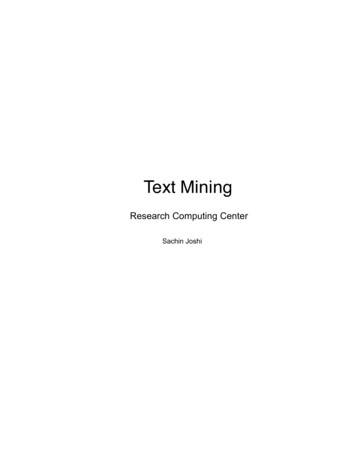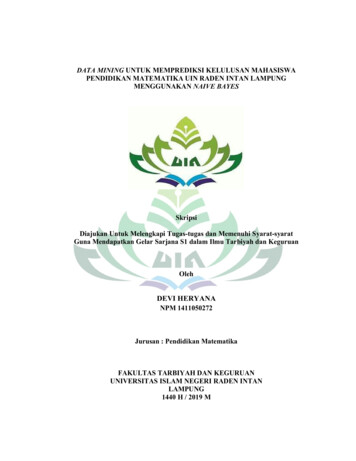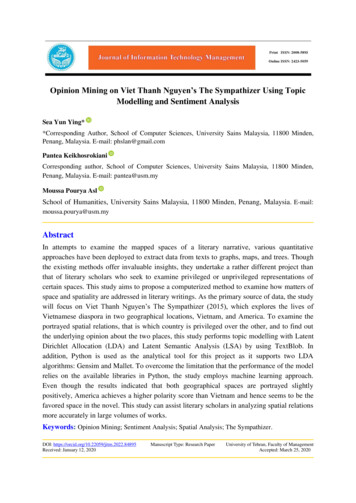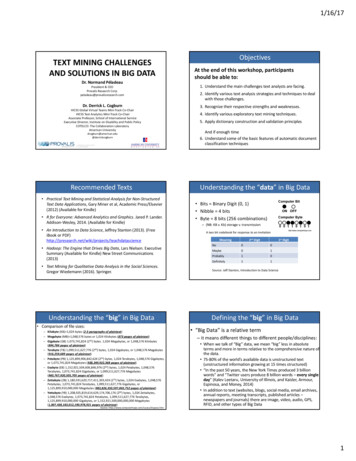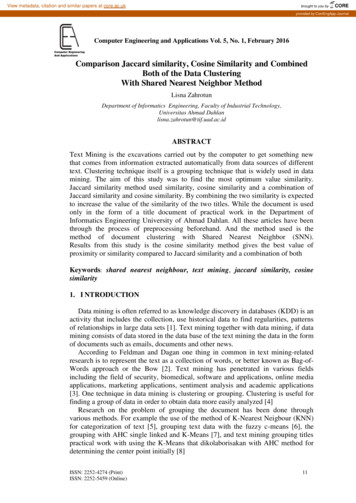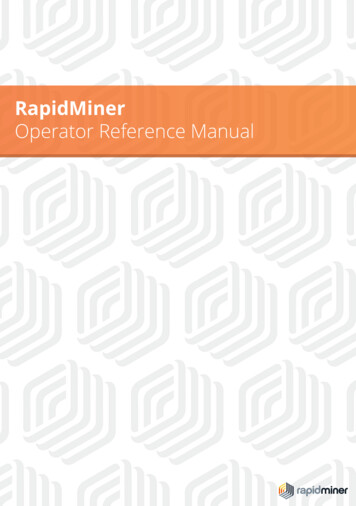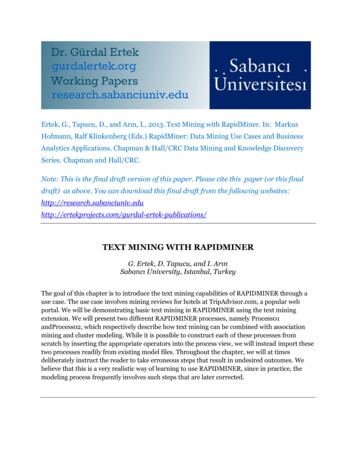
Transcription
Ertek, G., Tapucu, D., and Arın, I., 2013. Text Mining with RapidMiner. In: MarkusHofmann, Ralf Klinkenberg (Eds.) RapidMiner: Data Mining Use Cases and BusinessAnalytics Applications. Chapman & Hall/CRC Data Mining and Knowledge DiscoverySeries. Chapman and Hall/CRC.Note: This is the final draft version of this paper. Please cite this paper (or this finaldraft) as above. You can download this final draft from the following ekprojects.com/gurdal-ertek-publications/TEXT MINING WITH RAPIDMINERG. Ertek, D. Tapucu, and I. ArınSabancı University, Istanbul, TurkeyThe goal of this chapter is to introduce the text mining capabilities of RAPIDMINER through ause case. The use case involves mining reviews for hotels at TripAdvisor.com, a popular webportal. We will be demonstrating basic text mining in RAPIDMINER using the text miningextension. We will present two different RAPIDMINER processes, namely Process01andProcess02, which respectively describe how text mining can be combined with associationmining and cluster modeling. While it is possible to construct each of these processes fromscratch by inserting the appropriate operators into the process view, we will instead import thesetwo processes readily from existing model files. Throughout the chapter, we will at timesdeliberately instruct the reader to take erroneous steps that result in undesired outcomes. Webelieve that this is a very realistic way of learning to use RAPIDMINER, since in practice, themodeling process frequently involves such steps that are later corrected.
USE CASES WITH RAPIDMINER
USE CASES WITH RAPIDMINERWorking TitleDr. Markus HofmannInstitute of Technology Blanchardstown, IrelandRalf KlinkenbergRapid-iA JOHN WILEY & SONS, INC., PUBLICATION
Copyright c 2012 by John Wiley & Sons, Inc. All rights reserved.Published by John Wiley & Sons, Inc., Hoboken, New Jersey.Published simultaneously in Canada.No part of this publication may be reproduced, stored in a retrieval system, or transmitted in any formor by any means, electronic, mechanical, photocopying, recording, scanning, or otherwise, except aspermitted under Section 107 or 108 of the 1976 United States Copyright Act, without either the priorwritten permission of the Publisher, or authorization through payment of the appropriate per-copy fee tothe Copyright Clearance Center, Inc., 222 Rosewood Drive, Danvers, MA 01923, (978) 750-8400,fax (978) 646-8600, or on the web at www.copyright.com. Requests to the Publisher for permission shouldbe addressed to the Permissions Department, John Wiley & Sons, Inc., 111 River Street, Hoboken, NJ07030, (201) 748-6011, fax (201) 748-6008.Limit of Liability/Disclaimer of Warranty: While the publisher and author have used their best efforts inpreparing this book, they make no representations or warranties with respect to the accuracy orcompleteness of the contents of this book and specifically disclaim any implied warranties ofmerchantability or fitness for a particular purpose. No warranty may be created ore extended by salesrepresentatives or written sales materials. The advice and strategies contained herin may not besuitable for your situation. You should consult with a professional where appropriate. Neither thepublisher nor author shall be liable for any loss of profit or any other commercial damages, includingbut not limited to special, incidental, consequential, or other damages.For general information on our other products and services please contact our Customer CareDepartment with the U.S. at 877-762-2974, outside the U.S. at 317-572-3993 or fax 317-572-4002.Wiley also publishes its books in a variety of electronic formats. Some content that appears in print,however, may not be available in electronic format.Library of Congress Cataloging-in-Publication Data:Use Cases with RapidMiner / Markus Hofmann. . . [et al.].Printed in the United States of America.10 9 8 7 6 5 4 3 2 1
to be added
CONTRIBUTORSSabancı University, Istanbul, TurkeySabancı University, Istanbul, TurkeySabancı University, Istanbul, TurkeyGURDAL ERTEK,DILEK TAPUCU,INANC ARIN,v
CONTENTS IN BRIEF1Text Mining with RapidMinerG. Ertek, D. Tapucu, and I. Arın1vii
CONTENTSList of FiguresList of Tables1Text Mining with RapidMinerG. Ertek, D. Tapucu, and I. Arın1.11.21.31.4Introduction1.1.1Text Mining1.1.2Data Description1.1.3Running RAPIDMINER1.1.4RapidMiner Text Processing Extension Package1.1.5Installing Text Mining ExtensionsAssociation Mining of Text Document Collection (Process01)1.2.1Importing Process011.2.2Operators in Process011.2.3Saving Process01Clustering Text Documents (Process02)1.3.1Importing Process021.3.2Operators in Process021.3.3Saving Process02Running Process01 and Analyzing the Results1.4.1Running Process011.4.2Empty Results for Process01xixiii11222247791315151518212123ix
xCONTENTS1.51.6Glossary1.4.3Specifying the Source Data for Process011.4.4Re-Running Process011.4.5Process01 Results1.4.6Saving Process01 ResultsRunning Process02 and Analyzing the Results1.5.1Running Process021.5.2Specifying the Source Data for Process021.5.3Process02 ResultsConclusions23272835383839404547
LIST OF FIGURES1.1The TripAdvisor data set31.2Running RAPIDMINER as administrator31.3RAPIDMINER splash screen when no extension packages are installed41.4Managing RAPIDMINER extension packages41.5Dialog box stating that no extension packages are yet installed51.6Updating RAPIDMINER51.7Installing extension packages for text mining51.8RAPIDMINER splash screen with the three extension packages installedfor text mining61.9Importing an existing process71.10Selecting the process to import81.11Operators for Process01 and the Parameters for ProcessDocuments from Files operator81.12Operators within the Process Documents from Files nested operator101.13Parameters for the operators within the Process Documents fromFiles operator11xi
xiiLIST OF FIGURES1.14Parameters for the operators in Process01121.15Configuring LocalRepository131.16Specifying the Root directory for LocalRepository141.17Storing Process01 in LocalRepository141.18Operators in Process02 and the Parameters for Process Documentsfrom Files operator15Operators within the Process Documents from Files nested operatorand the Parameters for the Generate n-Grams (Terms) operator161.20Parameters for the operators in Process02161.21Saved processes within LocalRepository191.22Renaming a process191.23Renaming Process01 correctly201.24Corrected names for Process01 and Process02 in LocalRepositoryand the corresponding files201.25Opening and running Process01211.26Dialog box alerting the switch to the result perspective211.27Result Overview for Process01 results221.28Specifying the data source text directories for Process01241.29Specifying the text directories241.30Specifying the text directories251.31Specified text directories261.32Running Process01 again271.33Running of Process01271.34Result Overview for Process01 results281.35WordList generated by Process01281.36Meta Data View for the ExampleSet generated by Process01291.37Data View for the ExampleSet generated by Process01291.38Table View for the AssociationRules generated by Process01301.39Graph View for the AssociationRules generated by Process01311.40Graph View for the AssociationRules, without the node labels311.41Filtering rules in the Graph View for the AssociationRules321.19
LIST OF FIGURESxiii1.42Document Occurences of the words in the WordList331.43Saving the WordList for Process01341.44Saving the ExampleSet for Process01341.45Saving the AssociationRules incorrectly, without selectingLocalRepository or another directory35Saving the AssociationRules correctly, selecting the directory to besaved into361.47Exporting the graph visualization as an image file371.48Specifying the directory to be saved into, the file name, and the file type371.49Switching to the design view381.50Opening and running Process02381.51Error message due to not specifying the source data for Process02391.52Specifying the text directories for the source data of Process02391.53Result Overview for Process02 results401.54Meta Data View for the ExampleSet generated by Process02,including the n-Grams41Data View for the ExampleSet generated by Process02, and therelative occurence frequency of the word absolut in hotel 73943.txt42Text View for the Cluster Model generated by Process02, displayingthe number of examples in each cluster42Folder View for the Cluster Model generated by Process02,displaying the examples in each cluster43Centroid Table for the Cluster Model generated by Process02,displaying the average frequency of each word in each cluster441.461.551.561.571.581.59Final view of LocalRepository with the processes and their results saved 44
LIST OF TABLESxv
CHAPTER 1TEXT MINING WITH RAPIDMINERG. Ertek, D. Tapucu, and I. ArınSabancı University, Istanbul, Turkey1.1INTRODUCTIONThe goal of this chapter is to introduce the text mining capabilities of RAPIDMINER through ause case. The use case involves mining reviews for hotels at TripAdvisor.com, a popular webportal. We will be demonstrating basic text mining in RAPIDMINER using the text miningextension. We will present two different RAPIDMINER processes, namely Process01 andProcess02, which respectively describe how text mining can be combined with associationmining and cluster modeling. While it is possible to construct each of these processes fromscratch by inserting the appropriate operators into the process view, we will instead importthese two processes readily from existing model files.Throughout the chapter, we will at times deliberately instruct the reader to take erroneoussteps that result in undesired outcomes. We believe that this is a very realistic way of learningto use RAPIDMINER, since in practice, the modeling process frequently involves such stepsthat are later corrected.Use Cases with RapidMiner, First Edition. By Hofmann, KlinkenbergCopyright c 2012 John Wiley & Sons, Inc.1
21.1.1TEXT MINING WITH RAPIDMINERText MiningText mining (also referred to as text data mining or knowledge discovery from textualdatabases), refers to the process of discovering interesting and non-trivial knowledge fromtext documents. The common practice in text mining is the analysis of the informationextracted through text processing to form new facts and new hypotheses, that can beexplored further with other data mining algorithms. Text mining applications typically dealwith large and complex data sets of textual documents that contain significant amount ofirrelevant and noisy information. Feature selection aims to remove this irrelevant and noisyinformation by focusing only on relevant and informative data for use in text mining. Someof the topics within text mining include feature extraction, text categorization, clustering,trends analysis, association mining and visualization.1.1.2Data DescriptionThe files required for this chapter, including the data and pre-built processes reside withina folder titled LocalRepository. The data used in this chapter comes from TripAdvisor.com, a popular web portal in the hospitality industry, and is shown in Figure 1.1.This publicly available data set contains the reviews and ratings (1 through 5) of clientsor customers for 1850 hotels. The original data was extracted by The Database and Systems Information Laboratory at the University of Illinois at Urbana-Champaign,and isavailable under http://sifaka.cs.uiuc.edu/ wang296/Data/. There are 1850 textdocuments in the original data set,corresponding to the reviews of 1850 hotels. Eachdocument contains all the reviews for that hotel. While it is possible to run text miningprocesses with the original data, we will be using a subset of the data containing onlythe first 100 text documents. The data set used in this chapter may be downloaded pp/09.zip or the short weblink http://bit.ly/Kzdn5x, as well as http://research.sabanciuniv.edu .1.1.3Running RAPIDMINERWhen running RAPIDMINER, it is strongly recommended to right click the mouse buttonon the start menu and Run as administrator, as shown in Figure 1.2, rather than simplyclicking or double clicking the executable or shortcut icon. By running as administrator, weare granted the permissions to install extension packages. Running the software withoutthe administrator rights may cause errors when trying to install updates, including theextension packages. Figure 1.3 shows the splash screen displayed when RAPIDMINER isrun for the first time or when it is run without any extensions installed. In Figure 1.3,the highlighted region is currently blank but it will later contain the icons for the installedextensions. When RAPIDMINER is loaded, the user starts with the welcome perspective (aperspective is a particular combination of views), as shown in Figure 1.4.1.1.4RapidMiner Text Processing Extension PackageRAPIDMINER is the most popular open source software in the world for data mining,and strongly supports text mining and other data mining techniques that are applied incombination with text mining. The power and flexibility of RAPIDMINER is due to theGUI-based IDE (integrated development environment) it provides for rapid prototyping
INTRODUCTION3Figure 1.1 The TripAdvisor data setFigure 1.2 Running RAPIDMINER as administratorand development of data mining models, as well as its strong support for scripting basedon XML (extensible mark-up language). The visual modeling in the RAPIDMINER IDEis based on the defining of the data mining process in terms of operators and the flow of
4TEXT MINING WITH RAPIDMINERFigure 1.3 RAPIDMINER splash screen when no extension packages are installedprocess through these operators. Users specify the expected inputs, the delivered outputs,the mandatory and optional parameters, and the core functionalities of the operators, and thecomplete process is automatically executed by RAPIDMINER. Many packages are availablefor RAPIDMINER, such as text processing, Weka extension, parallel processing, web mining,reporting extension, series processing, PMML, community, and R extension packages. Thepackage that is needed and used for text mining is the Text Processing package, which canbe installed and updated through the Update RapidMiner menu item under the Help menu.1.1.5Installing Text Mining ExtensionsWe will initiate our text mining analysis by importing the two previously built processes.However, even before that we have to check and make sure that the extensions required fortext mining are installed within RAPIDMINER. To manage the extensions, select the Helpmenu and then manage Extensions menu item, as shown in Figure 1.4. The dialog boxthat comes up, as shown in Figure 1.5, does not list any extensions. Thus, the extensionsrequired have to be installed.Figure 1.4 Managing RAPIDMINER extension packages
INTRODUCTIONFigure 1.5 Dialog box stating that no extension packages are yet installedFigure 1.6 Updating RAPIDMINERFigure 1.7 Installing extension packages for text mining5
6TEXT MINING WITH RAPIDMINERClick the Close button and select Help menu and then Update RapidMiner menu itemas shown in Figure 1.6. RAPIDMINER will connect to the internet and fetch the list ofavailable updates, eventually displaying all the available updates, as in Figure 1.7. In thiswindow, the selection of an update for installation can be made only by double clickingthe check box on the left hand side of that update’s name. When an update is selectedfor installation, a small green check sign appears on the check box, as in Figure 1.7. Theextension packages (available as updates) needed for text mining are Text Processing,Web Mining, and Wordnet Extension. Select these updates as shown in Figure 1.7.Then, click the install button. When the Terms of Use window appears, click the radiobutton for I accept the terms of use, and click Ok . During the installation of updates,the installation process can be stopped by first clicking inside the Progress window, andclicking Stop , but don’t do this now. When the Update Complete dialog box appears,click Yes to restart RAPIDMINER with the newly installed updates available . When thesplash screen for RAPIDMINER is displayed, you will notice that the icons for the installedextensions appear in the previously blank region (Figure 1.8).Figure 1.8RAPIDMINER splash screen with the three extension packages installed for text mining
ASSOCIATION MINING OF TEXT DOCUMENT COLLECTION (Process01)1.21.2.17ASSOCIATION MINING OF TEXT DOCUMENT COLLECTION(Process01)Importing Process01We will now initiate the text mining analysis by importing the processes supplied with thischapter. For this, select Files and then the Import Process menu item as in Figure 1.9. Goto the LocalRepository folder (supplied with this chapter), then to Processes folder,click on Process01.rmp, and click the Open button, as in Figure 1.10. The RAPIDMINERprocess Process01 is now displayed in the design perspective, as shown in Figure 1.11.Figure 1.9 Importing an existing process
8TEXT MINING WITH RAPIDMINERFigure 1.10Figure 1.11operatorSelecting the process to importOperators for Process01 and the Parameters for Process Documents from Files
ASSOCIATION MINING OF TEXT DOCUMENT COLLECTION (Process01)1.2.29Operators in Process01The parameters for the operators in this process are given on the right-hand side of theprocess, listed under the Parameters tab. For the first process, the parameter text directories specifies where to read the text data from. A very important parameter is thevector creation used. In Process01, the selected vector creation method is TF-IDFTF-IDF (Term Frequency-Inverse Document Frequency) is a term weighting method. Itgives higher weight to terms that appear frequently in the document but not many times inother documents. However, this may yield too many words, even up to tens of thousands ofthem. Too many words would make it prohibitive to carry out the successive data miningsteps due to lengthy running times for the data mining algorithms. Hence, it is a very goodidea to prune the resulting word set using a prune method, by selecting the method andits parameters within the Parameters view.Click on the Process Documents from Files operator, as in Figure 1.11. In Process01, words that appear in less than 70.0 % of the documents are pruned, as can be seenfrom the value of 70.0 for the prune below percent parameter. It is also possible to prunethe words that appear in too many documents, but this was not done in this example, as canbe seen from the value of 100.0 for the prune above percent parameter. In associationmining, we are interested in the items (words in text mining context) that appear in 100.0%of the transactions (documents in our text mining context), since they can form interesting frequent itemsets (word lists) and association rules, that provide actionable insights.Thus, it is appropriate to set prune above percent to 100.0 in Process01 (Figure 1.11),including the items (words) that appear in every document.Process01 consists of five operators (Figure 1.11). Firstly, the Process Documentsfrom Files operator performs text processing which involves preparing the text data forthe application of conventional data mining techniques. Process Documents from Filesoperator reads data from a collection of text files and manipulates this data using textprocessing algorithms. This is a nested operator, meaning that it can contain a sub-processconsisting of a multitude of operators. Indeed, in Process01, this nested operator containsother operators inside. Double click on this operator, and you will see the sub-processinside it, as outlined in Figure 1.12. This sub-process consists of six operators that areserially linked (Figure 1.12): Tokenize Non-letters (Tokenize) Tokenize Linguistic (Tokenize) Filter Stopwords (English) Filter Tokens (by Length) Stem (Porter) Transform Cases (2) (Transform Cases)
10TEXT MINING WITH RAPIDMINERFigure 1.12 Operators within the Process Documents from Files nested operator
ASSOCIATION MINING OF TEXT DOCUMENT COLLECTION (Process01)Figure 1.1311Parameters for the operators within the Process Documents from Files operator
12TEXT MINING WITH RAPIDMINERThe sub-process basically transforms the text data into a format that can be easilyanalyzed using conventional data mining techniques such as association mining and clustermodeling. The parameters for each of the operators in this sub-process (within the ProcessDocuments from Files operator) are displayed in Figure 1.13. Notice that Figure 1.13was created manually by combining multiple snapshots.In this sub-process, the Tokenize Non-letters (Tokenize) and Tokenize Linguistic(Tokenize) operators are both created by selecting the Tokenize operator, but with differentparameter selections. The former operater tokenizes based on non letters whereas the latteroperater tokenizes based on the linguistic sentences within the English language. TheFilter Stopwords (English) operator removes the stop words in the English language fromthe text data set. The Filter Tokens (by Length) operator removes all the words composedof less than min chars characters and more than max chars characters. In this example,words that have less than 2 characters or more than 25 characters are removed from thedata set. The Stem (Porter) operator performs stemming and the Transform Cases(2)(Transform Cases) operator transforms all the characters in the text into lower case. Itshould be noted that the name of this last operator is not a good name, and we, as themodelers have forgotten to rename the operator after its name was automatically assignedby RAPIDMINER. This mistake should be avoided in constructing the processes.Figure 1.14 Parameters for the operators in Process01
ASSOCIATION MINING OF TEXT DOCUMENT COLLECTION (Process01)13The parameters for each of the operators in Process01 (Figure 1.11) are displayedin Figure 1.14. Notice that Figure 1.14 was created manually by combining multiplesnapshots. The Text to Nominal operator transforms the text data into nominal (categorical)data. The Numerical to Binomial operator then transforms the data into binominalform. This means that each row represents a document, a few columns provide metadata about that document and the remaining columns represent the words appearing inall the documents, with the cell contents telling (true or false) whether that word existin that document or not. FP-Growth algorithm is used for identifying the frequent itemsets. In this example, the min support parameter is 0.7 (Figure 1.14), meaning that theoperator generates a list of the frequent sets of words (itemsets) that appear in at least 70% of the documents. Notice that, it will be computationally efficient to select the minsupport value in the FP-Growth operator to be equal to prune below percent value forthe Process Documents from File operator (Figure 1.11) divided by 100. Also, themax items parameter is 2, meaning that the generated list is limited to pairs of words(2-itemsets), and the list will not contain frequent word sets (itemsets) with 3 or morewords in them. The final operator in Process01, namely Create Association Rules,receives the list of frequent word sets from the FP-Growth operator, and computes therules that satisfy the specified constraints on selected association mining criteria. In thisexample, the association rules are computed according to the the criterion of confidence,as well as gain theta and laplace k. The specified minimal values for these 3 criteria are0.8, 1.0 and 1.0, respectively.1.2.3Saving Process01So far Process01 has been imported in to the workspace of RAPIDMINER. Now it is agood time to keep it in the LocalRepository so that we will not have to import it againnext time we work with RAPIDMINER. Click on the Repositories view, right-click onthe LocalRepository and select Configure Repository as shown in Figure 1.15. Thisis actually an initialization step before using RAPIDMINER for the first time, but we willstill go through this step to ensure that we are saving everything to a preferred folderdirectory in our computer. In this chapter, we will be saving everything under the Rootdirectory of C:\RapidMiner, as in Figure 1.16. Next, we can save Process01 in to theLocalRepository. Right-click on the LocalRepository text and select Store ProcessHere, as in Figure 1.17. When the Store Process dialog window appears, click Ok. Ourimporting and saving of Process01 is now completed.
14TEXT MINING WITH RAPIDMINERFigure 1.15Figure 1.16Configuring LocalRepositorySpecifying the Root directory for LocalRepositoryFigure 1.17 Storing Process01 in LocalRepository
CLUSTERING TEXT DOCUMENTS (Process02)1.315CLUSTERING TEXT DOCUMENTS (Process02)The second text mining process that we will introduce in this chapter is Process02, andinvolves the clustering of the 100 documents in the text collection.1.3.1Importing Process02To import this process, select File menu, Import Process menu item, select Process02.rmpwithin the Import Process window, and click Open.1.3.2Operators in Process02Process02 is given in Figure 1.18. Similar to Process01, Process02 begins with theProcess Documents from Files operator, whose parameters are given in Figure 1.18.In Process02, the selected vector creation method is different; it is Term Frequency.The impact of this new selection will be illustrated later. For now, it should be noted thatthis selection results in the computation of the relative frequencies of each of the wordsin each of the documents in the data set. For example, if a word appears 5 times withina document that consist of 200 words, then the relative frequency of that word will be5/200 0.025. This value of 0.025 will appear under the column for that word, at therow for that document. In Process02, the prune method is again percentual, just as inProcess01 (Figure 1.11). However, the value for the prune below percent parameter isnow different.Figure 1.18operatorOperators in Process02 and the Parameters for Process Documents from Files
16TEXT MINING WITH RAPIDMINERFigure 1.19 Operators within the Process Documents from Files nested operator and theParameters for the Generate n-Grams (Terms) operatorFigure 1.20 Parameters for the operators in Process02The prune below percent parameter in Process01 was 70.0, whereas it is now 20.0in Process02. The reason for this change is due to the fact that the applied data miningtechnique in Process01 is association mining, whereas in Process02 it is clustering.
CLUSTERING TEXT DOCUMENTS (Process02)17The former technique is computationally much more expensive then the latter, meaningthat running association mining algorithms on a data set takes much longer running timecompared to the k-Means clustering algorithm on the same data set. Therefore, with thesame amount of time available for our data mining process, we have to work with muchsmaller data sets if we are carrying out association mining, as in Process01. The valuesdisplayed in Figures 1.11 and 1.18 have been determined through trial and error, such thatthe running time for the processes do not exceed 30 seconds on a laptop with Intel i5processor and 4GB RAM.
18TEXT MINING WITH RAPIDMINERFigure 1.19 shows the contents of this operator. While there were six operators within thisnested operator in Process01, there are now seven operators in Process02. The newlyadded operator is Generate n-Grams (Terms). The only parameter for this operator ismax length which is set equal to 2 in our example (Figure 1.19).The parameters for the Select Attributes and Clustering (k-Means(fast)) operatorswithin Process02 are displayed in Figure 1.20. The Select Attributes operator takesthe complete data set and transforms it into a new one by selecting only the columns withnumeric values, i.e. columns corresponding to the words. This transformation is requiredfor the next operator, which performs clustering based on numerical values. Clustering(k-Means (fast)) operator carries out the k-Means clustering algorithm on the numericaldata set. Since each row of the data (each document in the text collection) is characterizedin terms of the occurrence frequency of words in it, this operator will place together thedocuments that have a similar distribution of the word frequencies. The k value, whichdenotes the number of clusters to be constructed, is set to 5 in our example.1.3.3Saving Process02Now, let us save Process02 into LocalRepository: Click on Repositories view, rightclick on LocalRepository view and select Store Process Here. When the store processdialog box appears click Ok. As shown in Figure 1.21, both processes are now saved underlocal repository. Since we had earlier defined the directory root for local repositoryas C:\RapidMiner, the saved processes will appear as .rpm (RAPIDMINER process) filesunder that directory.Unfortunately, there is a problem with the naming of the files: the file names also containthe extension .rpm, in addition to the .rpm extension itself. For example, the correct namefor Process01rmp.rmp under C:\RapidMiner should be Process01.rmp. Right clickon Process01.rmp text within RAPIDMINER, and select rename as in Figure 1.22 then,as in Figure 1.23 remove the .rmp extension from the file name and click OK. Do the samefor renaming Process02 and you will obtain the results in Figure 1.24.
CLUSTERING TEXT DOCUMENTS (Process02)Figure 1.21Saved processes within LocalRepositoryFigure 1.22Renaming a process19
20TEXT MINING WITH RAPIDMINERFigure 1.23Renaming Process01 correctlyFigure 1.24 Corrected names for Process01 and Process02 in LocalRepository and thecorresponding files
RUNNING Process01 AND ANALYZING THE RESULTS1.421RUNNING Process01 AND ANALYZING THE RESULTSHaving imported and saved the processes into local repository, now we
Text mining (also referred to as text data mining or knowledge discovery from textual databases), refers to the process of discovering interesting and non-trivial knowledge from text documents. The common practice in text mining is the analysis of the information extracted through text processing to form new facts and new hypotheses, that can be


